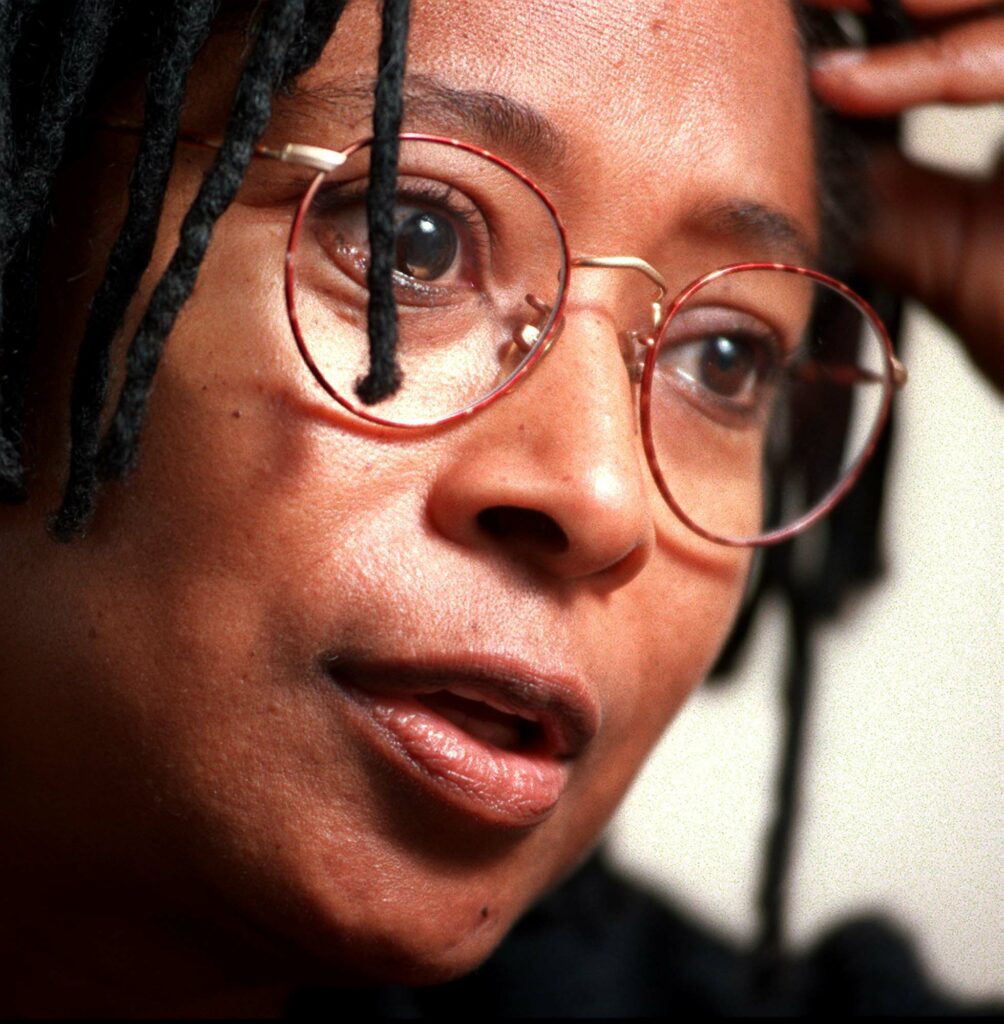The Color Purple is the international best-selling novel by Alice Walker, an African American writer from Eatonton.
Published in 1982, Walker’s epistolary tale chronicles the startling tragedy and triumph of a poor Black woman named Celie in her struggle for self-empowerment, sexual freedom, and spiritual growth in rural Georgia in the early twentieth century. The novel has received numerous awards, including the Pulitzer Prize for Fiction and the National Book Award, and was nominated for the National Book Critics Circle Award. As a film directed by Steven Spielberg and produced by Quincy Jones in 1985, The Color Purple was nominated for eleven Academy Awards.
The Novel
The Color Purple opens just after the turn of the century, when Celie is fourteen years old. She has been raped and impregnated by the man she believes is her father (but who is really, she later discovers, her stepfather). Afterward he warns, “You better not never tell nobody but God. It’d kill your mammy.” This chilling preface initiates the journal entries that Celie writes and addresses as letters to God. The act of writing becomes a crucial medium of self-discovery for Celie, allowing her to divulgeher secret humiliation and pain while charting a growing awareness of the world around her. Critics have often praised Walker’s forthright depiction of taboo subjects in the novel and her clear rendering of folk idiom and dialect through Celie’s written voice.
When Celie gives birth to a second child by her stepfather, the infant boy is taken from her and presumably killed. She is then forced to marry a widowed farmer named “Mr. _____” in order to care for his home and his four children. Her letters detail the cruel emotional and physical abuse she receives from her husband. Further intensifying her loneliness is the fact that her prearranged marriage requires her to separate from her beloved sister, Nettie.
Yet Celie forges an unusual kinship with her husband’s former mistress, the blues singer Shug Avery. Their relationship features both erotic and spiritual dimensions that not only defy social conventions but also culminate in a more self-affirming vision of existence. Shug encourages Celie to honor her own desires and to praise God through admiration. Indeed, it is Shug who states, “I think it pisses God off if you walk by the color purple in a field somewhere and don’t notice it.”

Courtesy of Atlanta Journal-Constitution.
Together the two women also discover letters from Celie’s sister that Mr. _____ kept hidden in a locked trunk. Years of correspondence from Nettie detail her experience as a Christian missionary in West Africa. Through the letters Celie learns that her two children, Adam and Olivia, are alive and have been adopted by Nettie’s benefactors, a preacher and his wife. Empowered by the existence of Nettie and her children, and strengthened by Shug’s love, Celie finds the courage to leave her oppressive household. She moves briefly to Shug’s residence in Memphis, Tennessee, and opens her own sewing business. After the death of her stepfather, Celie returns to Georgia to live in her newly inherited house. There she achieves a satisfying measure of financial security and independence, and even makes a tenuous reconciliation with Mr. _____. At the conclusion of the novel, Nettie returns to America, and Celie is reunited not only with her sister but with her grown son and daughter as well.
The Film
In 1984 music producer Quincy Jones bought the film rights to the novel, although Walker initially doubted whether it should be made into a movie. The film director Steven Spielberg, who had been given the book by his collaborator, Kathleen Kennedy, saw it as a chance to demonstrate that he could make a serious drama and thus overcome a reputation established by his action and fantasy films, such as Jaws, E.T., and the Indiana Jones series. He met with Walker in San Francisco, where she lived, and convinced her that he shared her vision for the characters and the story. She agreed to allow him to direct the film, and she served as a consultant on the set. She wrote a screenplay as well, though Spielberg rejected it in favor of an adaptation by Dutch-born screenwriter Menno Meyjes.
Walker was also instrumental in casting Whoopi Goldberg as Celie. Goldberg was at the time a stand-up comedienne performing in the San Francisco area, and even though she had never acted, she wrote to Walker, asking to be considered for the role of Celie if the book was ever filmed. Also appearing for the first time onscreen was Oprah Winfrey, then a popular local talk-show host in Chicago, who played the strong-willed Sofia, the wife of Celie’s stepson. The part of Shug Avery was portrayed by another unknown actress, Margaret Avery, although such well-known entertainers as Tina Turnerand Diana Ross had been considered for the part. All three actresses were nominated for Academy Awards for their performances. Danny Glover, a more established star, played the central male role of “Mister.”
Location filming for The Color Purple took place in the summer of 1985 near Monroe, North Carolina, after it was determined that modern development in Eatonton, Walker’s hometown, rendered it unsuitable.
The film, which cost nearly $15 million to make, generated about $142 million in box-office sales after its release in December 1985, and it quickly became the subject of much critical praise and controversy. While some reviewers criticized as unjustly negative Walker’s portrayal of Black men, such organizations as the Coalition against Black Exploitation expressed concerns that the story promoted the lesbian relationship of Celie and Shug as a remedy to the difficulties between Black men and women. Other reviewers noted that the film was a “Spielbergized” version—far more upbeat, affirmative, and prettified—of a world that Walker portrayed as harsh, impoverished, and bleak. Despite eleven Academy Award nominations, the film won no Oscars, perhaps because of these controversies.
Ten years after the film’s release, however, Walker expressed her satisfaction with the production and addressed her harshest critics in a 1996 book entitled The Same River Twice: Honoring the Difficult. The book features Walker’s rejected screenplay of The Color Purple. Essays in the collection discuss the author’s personal struggles during the making of the film, from her mother’s declining health and a troubled romantic relationship to her own battle against Lyme disease. The Same River Twice also includes articles about the film’s production and numerous letters from supportive fans.
A two-disc DVD rerelease of The Color Purple debuted in early 2003. In addition to behind-the-scenes footage, the special edition features background information on the novel, interviews with Walker and the film’s actors and actresses, and a documentary tribute to the original songs composed by Quincy Jones.
The Musical
In September 2004 the Alliance Theatre in Atlanta produced a musical stage version of The Color Purple. Once Walker overcame her initial reluctance to see her novel adapted for the theater, the Pulitzer Prize-winning playwright Marsha Norman (who won a Pulitzer for drama in 1983, the same year Walker won hers for fiction) was commissioned to write the script. Composers Brenda Russell, Allee Willis, and Stephen Bray provided a varied musical score consisting of blues, jazz, gospel, swing, and African music. The Atlanta production opened to generally positive reviews and Walker’s endorsement.

Courtesy of Atlanta Journal-Constitution.
The musical opened on Broadway in December 2005, produced by Quincy Jones and Oprah Winfrey, among others. LaChanze, the actress playing the role of Celie, won the Tony Award in 2006 for Best Performance by a Leading Actress in a Musical.








